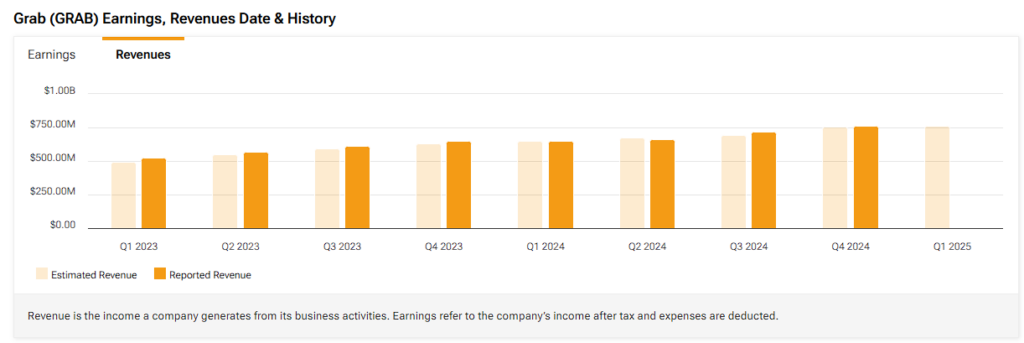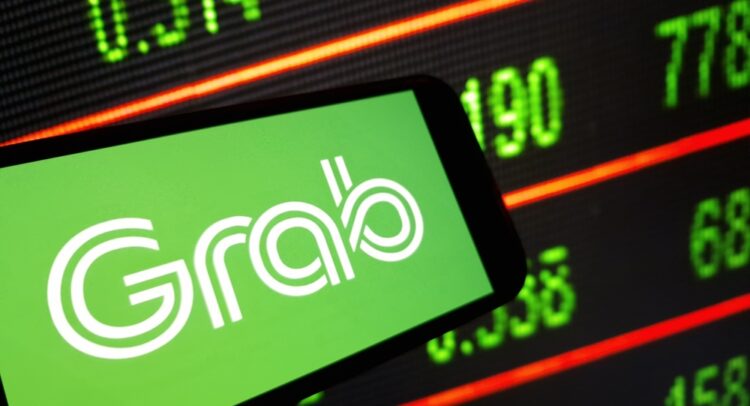Southeast Asia’s digital economy is booming, and Grab Holdings (GRAB) has quietly positioned itself as a top investment for those seeking non-U.S. exposure in their portfolios. Covering mobility, deliveries, and financial services, the Singapore-based super app is gradually crawling toward profitability while boasting a cash reserve that provides a significant margin of safety and M&A opportunities.
GRAB sports nimble financials as part of an astute broader market strategy, which has not yet been noticed by a wider audience. Moreover, the stock remains deeply undervalued due to an “Asia discount” that may translate to substantial gains despite shares already surging 53% over the past year. I’m leaning bullish on this Southeast Asian tech gem despite macro and political headwinds.

A Super App Powerhouse Turning Profitable
No one can argue against the fact that Grab has come a long way. From an up-and-coming ride-hailing player, it has steadily grown into an irreplaceable ecosystem for over 680 million people across eight Southeast Asian nations. In its latest report, the company celebrated a 17% revenue increase to $764 million and an $11 million profit, marking a pivotal shift from its cash-burning days.
Full-year free cash flow reached $136 million, a monumental improvement from a negative $234 million last year, with the company now starting to stack on the balance sheet and creating meaningful shareholder value.

Looking deeper into the financials, Grab’s balance sheet is stellar. With virtually no debt, $6 billion in cash (about a third of its current market cap), a clear path to positive EPS in 2025, and free cash flow in the green, GRAB’s bustling net position is set to grow. In fact, we should see free cash flow surging as its margins expand with scale. Revenue is projected at ~$3.4 billion for 2025, implying a growth of ~20% and setting up prospects of a robust operating and free cash flow margin expansion.
The Treasure Enabled by Asia’s Discount
The fascinating aspect of Grab’s bullish investment case is that the stock trades with an “Asia discount.” Historically, Western investors often undervalue Asian tech stocks (and GRAB is trading on the Nasdaq), tend to be incredibly cautious about regulatory risks or competition and assign notably lower multiples than their American peers.

For context, Grab’s P/S ratio is 5.7, higher than Uber’s 3.1, but a bargain given its momentous growth trajectory. Grab’s Q4 GMV hit $5 billion (up 20%), and its financial services arm, offering payments and even micro-loans now, is tapping into a massive unbanked market.
Yet, the stock’s priced as if it’s still a speculative venture. On the contrary, consensus estimates see free cash flow skyrocketing to $513 million this year. Grab’s $6 billion cash reserves could prove highly useful in this context as the company could fund share buybacks, innovation, and/or a transformative acquisition.
Strategic Plays Lighting GRAB’s Fuse
With GRAB’s $6 billion war chest now common knowledge, speculators are busy wondering how Grab plans to deploy it. Earlier this month, reports emerged of revived talks of a Grab merger with rival GoTo, where the combined company forms a $7 billion-plus powerhouse. Of course, antitrust challenges could complicate the deal, but if successful, I think it’s safe to say that Grab’s regional dominance would strengthen significantly.
But even without the deal, Grab is still making real advancements. Its partnership with Amazon Web Services boosts its tech backbone, while a BYD deal for 50,000 electric vehicles should cut costs and allow for extra scale. In the meantime, the financial services segment is quietly outpacing mobility, so I view it as an overlooked asset that investors can acquire along with the core business.
Is GRAB Undervalued?
Beyond the Asia discount, sentiment has been lukewarm. Last quarter didn’t trigger a noteworthy buyback despite that cash, while takeover targets like GoTo and Foodpanda keep the pressure on. That said, Grab’s economic footprint is undeniable. The company is adding 1% to Thailand’s GDP and 0.5% to Malaysia’s, per recent studies.

In the meantime, the stock is trading at just 35x this year’s expected free cash flow. In another context, this would be a pricy multiple, but with free cash flow now positive and accelerating, it is a modest one. It’s also worth noting that excluding its existing cash, Grab’s P/FCF falls to just 27x.
What is the Future Price of GRAB Stock?
Looking at Wall Street’s sentiment on the stock, GRAB features a Strong Buy consensus rating based on 10 Buys and two Holds assigned in the past three months. GRAB’s average price target of $5.65 per share implies approximately 22.5% upside potential over the next twelve months.

Standing Out in Southeast Asia
Grab’s transformation into a profitable, cash-flush super app company makes it a Southeast Asian standout opportunity at current price levels. The stock’s Asia discount suggests it remains undervalued, just as 2025 is projected to become another year of incremental revenue growth, margin expansion, and cash growth.
In the meantime, the potential for M&A fireworks is growing, but even if the deal with GoTo doesn’t materialize, the upside feels significant at ~$4.50 per share. The safety net is also broad, given the cash-rich balance sheet and already pessimistic sentiment surrounding the stock.
















